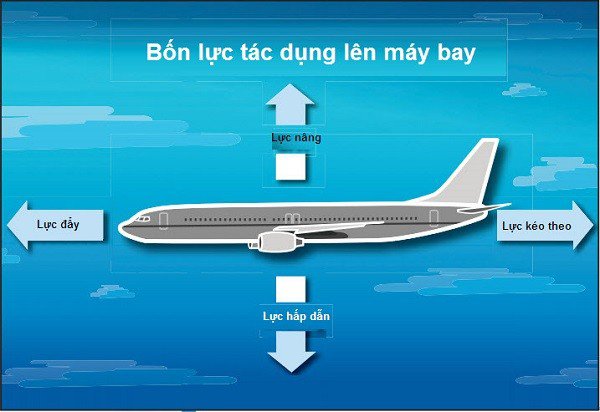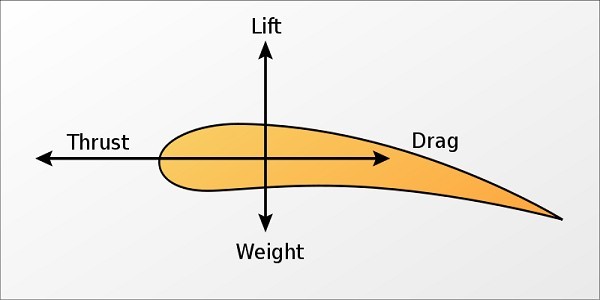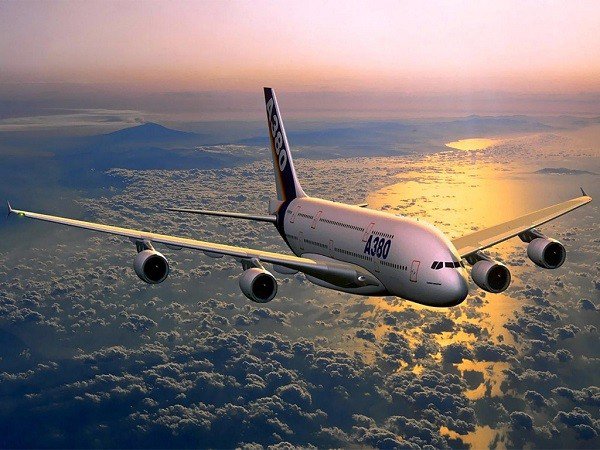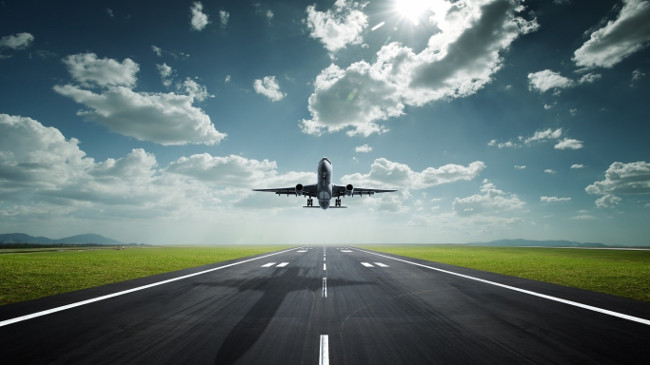Why can airplanes fly in the sky?
With enormous size and mass carrying hundreds of passengers and tons of luggage, why does the plane fly in the sky?
The plane has become a familiar means of transportation for many people, but very few people have asked the question.
Find out about the mechanism of operation when the aircraft takes off, lands, and flies in the sky . to answer this question.
Flight mechanism of aircraft
With a total weight of hundreds of tons, what force can lift the plane from the ground? That is the aerodynamic lifting force also known as Joukowski lifting force .

A moving plane must be affected by 4 forces: traction, air resistance, gravity, lift force.
As the aircraft moves on the runway, the air flow around the wing will create a pressure difference between the underside of the wing and the top of the wing that causes a lift in the direction from the ground to the sky.

Lift model helps the aircraft take off.
This force is proportional to the square of the travel speed and the wing area of the aircraft, the faster the aircraft moves, the greater the force. So before taking off, the plane needs to move a distance on the ground to achieve the necessary speed until it creates a force to win the earth's gravity and lift it into the air. In the process, two wings of the aircraft are controlled to change the lifting angle to change the lift force.
How does the airplane wing work?
Aircraft operating in the air
Normally, commercial airplanes only fly in the upper part of the troposphere of the atmosphere, the height is about 10.7km. In fact, airplanes can fly at any height, but why does the plane only fly at that altitude?

Thunderstorms, the rise and fall of air currents are all dynamic within the lowest range of the atmosphere 10,000m. If flying within less than 10,000 meters of aircraft will be affected by the up and down air flow, so that the aircraft cannot fly in a stable manner. In addition, if you encounter water particles and ice particles with low temperature, the outer case may freeze. That's not to mention at this altitude, sometimes aircraft can be struck by lightning.
With altitudes above 10,000m, it is completely different, at this altitude is relatively quiet, the aircraft can operate stably. In addition, the air layer at that height is very thin, low in water vapor so the outer shell is not frozen.
Why do passenger aircraft fly at an altitude of 10,700 m?
In 1976, the US SR-71 Blackbird aircraft reached a world record with a height of nearly 26km above sea level.
Aircraft landing mechanism

When approaching the ground, the air below the wing is pressed to the ground, creating small swirls as well as creating "ground effect" that causes the aircraft to lift for a short time before being stay on the runway.
You should read it
- Surprising facts about aircraft tires not everyone knows
- Why is the passenger door up and down on the left side of the plane?
- Why is the airplane wing not so high in flying tape?
- Aircraft and 11 unexpected secrets that not everyone knows
- How to repaint an entire aircraft?
- The largest aircraft in the world looks like a 'butt' taking off for the first time
- Google opened the Wing unmanned aircraft service
- Why does lightning do not affect aircraft while flying?
May be interested
- How to use the software on the plane 300 million USD
 in general, lag does not belong to computers but aircraft and other machines are 'expensive' and the way to 'correct' is the same.
in general, lag does not belong to computers but aircraft and other machines are 'expensive' and the way to 'correct' is the same. - The inventions show the sublime intelligence of Leonardo da Vinci
 he invented robots, self-propelled cars and airplanes. where to find another genius like da vinci?
he invented robots, self-propelled cars and airplanes. where to find another genius like da vinci? - Why do airplanes almost never have a flat tire?
 it is a fact that it is never or very rare for an aircraft to have a tire blown out while traveling on the runway or landing.
it is a fact that it is never or very rare for an aircraft to have a tire blown out while traveling on the runway or landing. - Why are there so many planes in the sky at the same time but they never collide with each other?
 today, airplanes are a popular means of transportation that many people choose. because of that, the sky became more crowded but almost never aircraft collided with each other, why?
today, airplanes are a popular means of transportation that many people choose. because of that, the sky became more crowded but almost never aircraft collided with each other, why? - Meaning of numbers on airport runways
 each symbol and digit on the runway has its own unique meanings that help the pilot locate the exact direction of travel when taking off.
each symbol and digit on the runway has its own unique meanings that help the pilot locate the exact direction of travel when taking off. - CO2 emissions will be used as fuel for cars in the future
 researchers at the massachusetts institute of technology have developed a new system that can be used to convert power plant co2 emissions into useful fuels for cars, trucks and airplanes.
researchers at the massachusetts institute of technology have developed a new system that can be used to convert power plant co2 emissions into useful fuels for cars, trucks and airplanes. - Do you know why airline tickets are so expensive or not?
 so have you ever wondered why airline tickets are so expensive? please join us to find out the cost of making a regular flight!
so have you ever wondered why airline tickets are so expensive? please join us to find out the cost of making a regular flight! - Why is the tail of the wing curved so oddly?
 this pointed part is called winglets - gliding wings, which help reduce swirling air and increase lift for the aircraft.
this pointed part is called winglets - gliding wings, which help reduce swirling air and increase lift for the aircraft. - Fire needs air to burn, so how does the rocket work in space?
 commercial airplanes and fighter planes burn fuel by using the oxygen available in the atmosphere, but what about those missiles flying into space? invite you to find out!
commercial airplanes and fighter planes burn fuel by using the oxygen available in the atmosphere, but what about those missiles flying into space? invite you to find out! - Wi-Fi on the plane and things you need to know before using
 with an on-board wifi service, customers can check mail or surf the web at a height of 40,000 feet. but don't rush to celebrate. find out about the wifi service on the plane a bit before making a final decision.
with an on-board wifi service, customers can check mail or surf the web at a height of 40,000 feet. but don't rush to celebrate. find out about the wifi service on the plane a bit before making a final decision.










 Why a day can last 25 hours in the future
Why a day can last 25 hours in the future Why is human hair silver?
Why is human hair silver? Why are you and many other countries in the world driving on the left?
Why are you and many other countries in the world driving on the left? Unexpected code decoding on New Year's Day
Unexpected code decoding on New Year's Day Why do beautiful girls often choose to love bad boys?
Why do beautiful girls often choose to love bad boys? Science proves better to be single than to love the wrong person
Science proves better to be single than to love the wrong person